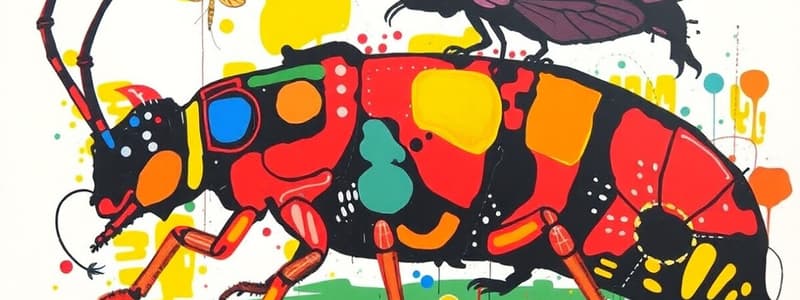Podcast
Questions and Answers
Besides the transmission of diseases and economic losses, why is it important to understand and control pests in both rural and urban environments?
Besides the transmission of diseases and economic losses, why is it important to understand and control pests in both rural and urban environments?
To prevent the transfer of disease and reduce the influence of pests as a public health threat.
List three ways economic losses can occur due to pests.
List three ways economic losses can occur due to pests.
Direct pest contact, contamination of produce, and damage to structures.
What is the first principle of pest control?
What is the first principle of pest control?
To limit access of the pests to the food source.
What is the second principle of pest control, regarding vermin?
What is the second principle of pest control, regarding vermin?
Describe the third preventative strategy for pest control.
Describe the third preventative strategy for pest control.
What is the first stage in reactive pest control?
What is the first stage in reactive pest control?
After establishing that you have pests in the proximity of a building, what is the next important step?
After establishing that you have pests in the proximity of a building, what is the next important step?
List four guiding principles for selecting an appropriate pest control method as it depends on multiple factors.
List four guiding principles for selecting an appropriate pest control method as it depends on multiple factors.
Why is it often necessary to prebait before applying rodenticides?
Why is it often necessary to prebait before applying rodenticides?
Why are baits typically moist?
Why are baits typically moist?
Describe the application method of 'rodenticidal dusts'.
Describe the application method of 'rodenticidal dusts'.
If a residual effect is required when applying insecticides, describe the four principle forms of application.
If a residual effect is required when applying insecticides, describe the four principle forms of application.
What is the purpose of using synergists like piperonyl butoxide with pyrethrins?
What is the purpose of using synergists like piperonyl butoxide with pyrethrins?
Describe the diastema, a feature of rodents.
Describe the diastema, a feature of rodents.
How do rodents primarily recognise their own environment?
How do rodents primarily recognise their own environment?
What are the four basic tastes that rodents can typically distinguish?
What are the four basic tastes that rodents can typically distinguish?
What is neophobia, as exhibited by rodents?
What is neophobia, as exhibited by rodents?
What is Kinaesthesis, and how does it affect rodent movement?
What is Kinaesthesis, and how does it affect rodent movement?
Name four diseases that rodents have been shown to carry.
Name four diseases that rodents have been shown to carry.
How does the appearance of the tail differ between a Brown rat and a Black rat?
How does the appearance of the tail differ between a Brown rat and a Black rat?
What is the preferred habitat of the Norway rat (Rattus norvegicus), and what is its water requirement?
What is the preferred habitat of the Norway rat (Rattus norvegicus), and what is its water requirement?
Describe the droppings of the House mouse.
Describe the droppings of the House mouse.
Describe the appearance of Brown Rat runways.
Describe the appearance of Brown Rat runways.
Describe the likely habitats for a Black rat.
Describe the likely habitats for a Black rat.
In environmental control of rodents, what is the purpose of providing kick plates on doors?
In environmental control of rodents, what is the purpose of providing kick plates on doors?
In environmental control of rodents, describe the specification of the wire meshing used for airbricks.
In environmental control of rodents, describe the specification of the wire meshing used for airbricks.
In environmental control of rodents, why use a high gloss final coat for paint bands.
In environmental control of rodents, why use a high gloss final coat for paint bands.
Name three methods of control against Grey squirrels.
Name three methods of control against Grey squirrels.
Name two ways to protect trees from bark stripping by squirrels.
Name two ways to protect trees from bark stripping by squirrels.
Why should banded red-brown worms not be used for mole poison?
Why should banded red-brown worms not be used for mole poison?
What is the only reliable method of control for protecting waterfowl from Mink?
What is the only reliable method of control for protecting waterfowl from Mink?
Outline the requirements for preventing domestic animals being predated on by foxes.
Outline the requirements for preventing domestic animals being predated on by foxes.
What control method for rabbits is illegal under the Control of Pesticides Regulations 1986.
What control method for rabbits is illegal under the Control of Pesticides Regulations 1986.
How can Pigeons cause problems?
How can Pigeons cause problems?
List 4 orders of Insecta.
List 4 orders of Insecta.
Name 3 orders of Insecta that undergo an incomplete metamorphosis.
Name 3 orders of Insecta that undergo an incomplete metamorphosis.
List four problems that Insects can cause.
List four problems that Insects can cause.
How do Silverfish feed?
How do Silverfish feed?
What is the food of choice for Booklice?
What is the food of choice for Booklice?
Describe the mouthparts and general feeding preferences of bed bugs.
Describe the mouthparts and general feeding preferences of bed bugs.
Flashcards
What is a pest?
What is a pest?
An organism destructive, noxious, or troublesome to humans or their interests.
Examples of invertebrate pests
Examples of invertebrate pests
Invertebrate pests include insects and mites.
Examples of vertebrate pests
Examples of vertebrate pests
Vertebrate pests include mammals and birds.
Direct transmission of disease
Direct transmission of disease
Signup and view all the flashcards
Indirect transfer of disease
Indirect transfer of disease
Signup and view all the flashcards
Preventative pest control
Preventative pest control
Signup and view all the flashcards
Vermin harbourage
Vermin harbourage
Signup and view all the flashcards
Effective housekeeping
Effective housekeeping
Signup and view all the flashcards
Signs of reactive pest control
Signs of reactive pest control
Signup and view all the flashcards
Forms of rodenticides
Forms of rodenticides
Signup and view all the flashcards
Space sprays
Space sprays
Signup and view all the flashcards
Dusting powders
Dusting powders
Signup and view all the flashcards
Synergists for Insecticides
Synergists for Insecticides
Signup and view all the flashcards
Rodents
Rodents
Signup and view all the flashcards
Diastema
Diastema
Signup and view all the flashcards
Neophobia in Rodents
Neophobia in Rodents
Signup and view all the flashcards
Kinaesthesis
Kinaesthesis
Signup and view all the flashcards
Diseases carried by rodents
Diseases carried by rodents
Signup and view all the flashcards
Rattus norvegicus
Rattus norvegicus
Signup and view all the flashcards
Rattus norvegicus tail
Rattus norvegicus tail
Signup and view all the flashcards
Rattus norvegicus colour
Rattus norvegicus colour
Signup and view all the flashcards
Black Rat
Black Rat
Signup and view all the flashcards
Droppings - Rattus rattus
Droppings - Rattus rattus
Signup and view all the flashcards
House Mouse
House Mouse
Signup and view all the flashcards
Smell
Smell
Signup and view all the flashcards
Urine Pillars
Urine Pillars
Signup and view all the flashcards
Smears
Smears
Signup and view all the flashcards
Common entrance
Common entrance
Signup and view all the flashcards
Any poison
Any poison
Signup and view all the flashcards
Anti-coagulant
Anti-coagulant
Signup and view all the flashcards
Enviromental control
Enviromental control
Signup and view all the flashcards
Grey Squirrel.
Grey Squirrel.
Signup and view all the flashcards
Poisons limited
Poisons limited
Signup and view all the flashcards
Trapping and Poison.
Trapping and Poison.
Signup and view all the flashcards
MINK import.
MINK import.
Signup and view all the flashcards
Mink Fencing.
Mink Fencing.
Signup and view all the flashcards
Adaptable fox fox.
Adaptable fox fox.
Signup and view all the flashcards
Deaths caused.
Deaths caused.
Signup and view all the flashcards
Creating burrows.
Creating burrows.
Signup and view all the flashcards
Gutting leading.
Gutting leading.
Signup and view all the flashcards
Study Notes
- Middlesex University, Faculty of Science & Technology produced the Pestology Reader and Workbook
- Alan Page and Adam Choonara compiled the information
- Module Tutor Salma Conner can be contacted at 020 8411 2695 or [email protected]
- Technical support is available from Milan Vu at 020 8411 3029 or [email protected]
Module 1 Content
- Pests and their impacts have been a consistent issue throughout history
- Pests cause harm through disease transmission to humans and livestock, economic losses from crop damage and contamination
- Changes like new production methods and increased travel have shifted pest prevalence
- Control is needed in both rural and urban environments to halt disease spread and pest impacts on public health
- The module concentrates on UK pests, their life cycles, habitats, infestation detection, and control methods
Learning Outcomes
- Recognize common vertebrate pests in the UK and know their life cycles and habitats
- Apply cognitive skills to spot vertebrate pest infestations
- Advise on and assess appropriate eradication for vertebrate pests in various settings, especially food
- Recognize common invertebrate pests, including those imported, and know their life cycles and habitats
- Apply cognitive skills to spot invertebrate pest infestations
- Advise on and assess appropriate eradication for invertebrate pests in various settings
- Understand the laws around pesticide use and storage
Course Structure
- The module aims to achieve its objectives with specialized knowledge unit
- The initial unit covers the connection between humans and pests, and why pest control is needed
- This is followed by exploring pest groups: mammals, birds, insects, and mites focusing on UK pests, their impacts, and controls
- The course culminates in a review of health/safety and pest control, including pesticide laws
Study Approach
- Teaching involves study units within this handbook as a starting point
- Further study involves practical sessions, videos, questions etc
Units of Learning
- An overview of major topics covered in the PESTOLOGY READER and WORKBOOK
- Introduction to the module, pests, their importance, and control principles (Study Unit 1)
- Mammalian pests, focusing on rodents: biology, behavior, and chemical control (Study Unit 2)
- Non-chemical rodent control, squirrels, other vertebrate pests, and legal controls (Study Unit 3)
- Avian pests, urban foxes, rabbits including their biology, characteristics, and control (Study Unit 4)
- Insect pests: taxonomy, arthropod characteristics, anatomy, physiology, and conditions they favor (Study Unit 5)
- Specific insect pests: Diptera, Hemiptera, Syphonptera, Hymenoptera, Dictyoptera, Orthoptera (Study Unit 6)
- Fabric and stored product insect pests (Study Unit 7)
- Insect pest chemical and physical controls (Study Unit 8)
- Insect pest biological control and legal guidelines (Study Unit 9)
- Pests of stored products, including food product pests (Study Unit 10)
Study Units Structure
- The units provide a review of key topics and common UK pests
- Studying the units in order is key
- The units include features to help with student learning and knowledge
- Review questions help to measure progress, solidify understanding, and enhance subject knowledge
- Exercises are detailed questions examining issues within the unit to test problem-solving skills.
Additional Materials
- Use provided reading lists, texts, and online resources to expand understanding
Time Management
- This is a larger module, expect to spend roughly 80 hours in study time
- Spend time on units, further research, and module exam preparation
- Develop a personal study schedule
Pest Control Definition
- A pest can be defined as any organism that is destructive, harmful, or irritating to humans or their interests
- This includes organisms damaging crops, livestock, or that are found in particular areas
Groups of Pests
- Invertebrate pests include insects and mites
- Vertebrate pests include mammals and birds
Reasons for Pest Control
- Health and Diseases: Pests can directly/indirectly transmit diseases to humans through bites, feeding, or allergens
- Indirect transmission can involve cross-contamination of food or water
- Pests may harm livestock with disease transmission to humans or adverse effects on livestock
- Economic Loss: Pests can damage stored products, crops, and structures
- Pests can thrive in an environment from the introduction of something new such as termites with climate change
- Producers can limit destruction by vaccination, herbicides and pesticides
Principles of Pest Control
- Preventative Controls: Pest-proofing can be achieved by limiting food source access such as proofing and sealing a building
- Preventative Controls: Control pest harborages to prevent the places for the pests can reside without too much disturbance by removing debris
Preventative Strategies
- Effective housekeeping reduces food sources if pests bypass proofing and involves keeping premises clean, tidy and free of debris
- Careful examination of supplies is imperative in order to prevent contamination from outside locations
Reactive Controls
- First, recognize the signs of a potential problem like webbing, rodent droppings or other signs
- Next, assess the approximate level of the identified infestation
- Thirdly, prescribe a strategy for destruction and immediate proofing in order to prevent from worsening
- Finally, implement the change safely, legally, and check and assess treatment impact
Methods of Control
- Control methods rely on the nature of the problem, the species involved and any environments
- Methods rely on amount of control, safety of anyone involved, legislation and any ethical considerations
Use of Rodenticides
- Rodenticides, used against rodents, can be acute (single dose) or chronic (multiple dose)
- Chronic rodenticides contain anti-coagulants
- Prebaiting is important due to caution from new-object disorders
- As such, baits are frequently moist and replaced in case they dry out
Insecticides
- Insecticides can be space sprays for immediate kills
- It is most effective to use active ingredients such as dusting powder, wettable powder and spray formulations
- Lacquers can be applied as a surface film
- Knockdown sprays may use pyrethrins and piperonyl butoxide.
Studying That Suits You
Use AI to generate personalized quizzes and flashcards to suit your learning preferences.




